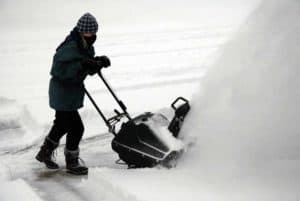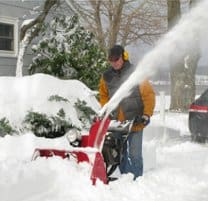 For many people the impulse to purchase a snow blower begins with the first snowflake, followed by a mad dash to one of few big-box retail outlets in hopes of finding the right machine at the right price.
For many people the impulse to purchase a snow blower begins with the first snowflake, followed by a mad dash to one of few big-box retail outlets in hopes of finding the right machine at the right price.
“We try to run as many promotions as we possibly can to get people to come out and buy early rather than wait,” said Jen King, a spokesperson for Home Depot based on the company’s Atlanta headquarters. “However, there are a lot of people that wait to purchase a snow blower at the last minute; when the snow begins to fall. We really do see a fairly significant uptick when there is a big snow storm.”
In fact, all of the people contacted for this story said there is something of a Pavlovian response to the site of the first flakes of winter. As one sales associate at a southern New Hampshire Lowe’s store put it, “People act on the weather. They hear we will get some snow and all of a sudden there is a run on snow blowers. Salt and roof rakes are the same. One minute they are on the shelves not moving and the next we can’t keep them in stock.”
With this past winter being one of the snowiest for quite some time, manufacturers kept their production lines running longer than they normally would. “Most snow blower manufacturers produce other equipment and change over their lines,” said Kris Kiser, Executive Vice President of the Outdoor Equipment Institute. “This year, though, they kept their lines going a bit longer to address increased demand. We heard from our members that you couldn’t find a snow thrower in early January.”
When to Buy? The Intersection of Cost and Selection
So then, is waiting till the last minute to buy a snow blower the smartest choice? Of course not say all of the experts. But when is the right time? Spring; when it seems likely the prior season’s merchandise is likely to be on sale? Summer; when people aren’t even thinking of snow?
 “Actually,” says Jon Hoch, founder and CEO of online retailer Snow Blowers Direct, “if you are looking for a deal and the best selection it’s best to start looking just before the snow season starts in August, September and early October. If you wait much later than that you may find a good price, but the selection will be a lot less.”
“Actually,” says Jon Hoch, founder and CEO of online retailer Snow Blowers Direct, “if you are looking for a deal and the best selection it’s best to start looking just before the snow season starts in August, September and early October. If you wait much later than that you may find a good price, but the selection will be a lot less.”
Kiser adds that it is important to keep an eye on the calendar. “You don’t want to wait until it’s too late, as we saw in New England, because availability will be low,” he said. “The timing of when retailers will bring them out can also depend on where you are. International Falls, Minnesota, for example, gets snow very early so product likely comes out early.”
In a moment we will describe why selection is important, but according to Hoch manufacturers and big box retailers are a savvy lot. Manufacturing is done in May, June and July. Retail inventories are kept strategically small in order to reduce the likelihood of being stuck with excess supply late in the season when most customers are looking for lawnmowers. The last two winters have put a fine point on this fact as snowfall has been heavy in the northern U.S. — even in on-again-off-again New England — causing in-store supplies to be at or near zero.
Hoch says that as of this writing his online retail outlet only has one model in stock. Meanwhile, the Lowe’s in southern New Hampshire doesn’t have any in stock, doesn’t know of another Lowe’s in the area that does, and doesn’t expect to have any until fall. The same is true at Home Depot where a sales associate said the store has none in stock and that the entire area is sold out.
King, Home Depot’s spokesperson, underlines this fact saying, “We have not had any problems selling them this year and even the manufacturers have been running out of their product because demand has been high.”
Online vs. In-Store Retail
With so much commerce being carried out online it is well worth considering whether to make your snow blower purchase from an online outlet or through a traditional retail outlet.
According to Jon Hoch, founder and CEO of online retailer Snow Blowers Direct, his company has a rather large selection early in the season as well as no sales tax and offers free shipping. He adds, “We are very competitive on price as well. Do you want to drive to the store and see the two that are left and then drag them through the store and home?”
On the other hand, says Abby Buford, spokesperson for Lowe’s, customers can research their option online and then come into the store where employees can answer any questions they may have as well as save on shipping charges. In addition, many retailers offer an online alternative.
Why Selection Matters
Not all snow blowers are created equal. Beyond brand differences there are also different types of snow blowers used to meet distinctly different needs. There are different features to consider too. Understanding these differences and your particular needs are critical to buying the right snow blower at the right price.
Two-Stage: These snow blowers employ an auger at its mouth to grind and pull snow in where it is then thrown/blown out via a fan-like impeller. These snow blowers tend to have larger engines and capacities (wider path and volume) than compared to the other categories. They work well for clearing larger areas in regions where snow tends to be deeper and/or heavier in terms of weight (wetter snow or icy conditions). These machines also tend to be a bit more expensive. According to a 2007 Consumer Reports story, they range in price from $600 to $2,100.
Single-Stage: As the name suggests, these snow blowers rely on only an auger to draw the snow in, grind it and then propel it out a discharge chute. These snow blowers tend to have smaller engines and capacity than the two-stage types and are better for clearing smaller areas and for regions where snowfall tends to be lighter. According to the same Consumer Reports story, these snow blowers range from $300 to $900.
Single Stage Electric: Like their gas powered brethren, these snow blowers rely on a single stage to lift and throw the snow, but are powered by an electric engine plugged into a wall socket. These tend to make less noise than gas powered machines, but the engines are less powerful and are designed for light snowfall and clearing much smaller areas such as walkways, decks and the like. Consumer Reports notes that they tend to run from about $100 to $300.
Cordless: A newer entry into the industry, these snow blowers have become more powerful as batteries improve. They’re best with lighter to moderate snowfall. Batteries can be expensive when purchasing a cordless, so its often recommended to choose a brand that you may own other cordless products from. Their biggest benefit is being lightweight and quiet. No maintenance such as oil changes are required either.
With such a wide selection and varied requirements, it is important to match your needs with the right snow blower. Waiting until the last minute or until after the season passes in order to look for a deal, could mean that you may be forced into purchasing a machine that either is more powerful than you need (and therefore more expensive) or less than you require causing breakdowns and/or being forced to go back to the store to purchase a more appropriate machine.
Looking For a Deal?
For those who need to find a good deal on a snow blower it is possible to wait for end-of-season clearance sales. According to Hoch, his company will negotiate with manufacturers looking to closeout a model and then purchase the remaining supply in order to offer his customers a reduced price.
While both spokespeople for Home Depot and Lowe’s would not discuss sales or other possible promotions at their stores, the two sales associates called at each store did say that when there is any remaining supply both companies will offer clearance sales. For Home Depot, sales could begin in February, March, or April. For Lowe’s, sales could begin to appear as early as January.
Kiser adds, “Like any consumer product it is seasonally marketed. During the off season you may find a snow thrower that has been discounted, the retailers tend to move their stock off the floor so you may not find them during the off months. The upshot is that if you wait until April or May, you may not find any, but there may be sales on the ones you do find.”
There is also the possibility that buying a snow blower when there isn’t any snow may raise issues in terms of warranties. You don’t want to wheel a machine home and then six months later when the warranty may have expired have a mechanical problem.
Another popular time is near the holidays. Stores run their Black Friday and Cyber Monday sales to entice customers into the store or to their website. Often times these are less popular snow blowers and brands that are looking to be unloaded. You typically won’t find your high end machines on sale at this time.
According to King at Home Depot and Abby Buford, a spokesperson for Lowe’s, it is important to check at the store and with the manufacturer the terms of any warranty to ensure you are protected. That said, Hoch notes that while it is a risk, most snow blowers come with a two-year warranty. “You’ll get two winters from a snow blower no matter how you map it,” he said.
For those looking for a better deal than what the retailers can provide, there are always CraigsList, Amazon, and eBay. According to data from eBay, snow blower listings this year have spiked in January and February with a sharp decline in late February/early March. For example, Boston area CraigsList had 89 listings, NH 100, Maine 75, Minneapolis/St. Paul 100, Denver 100, and so on. Searches on Amazon and eBay showed good selection, but at varying prices and shipping charges.
Of course, the usual caveats apply when buying from one of these websites as you are often reliant on the honesty of the seller. Purchasing a used piece of equipment, and buying without a manufacturer’s warranty is a risk. However, when prices for new two or single-stage snow blowers can average $600 to $1000 and more, these alternatives sources offer a chance to purchase the right machine at a greatly reduced price.
